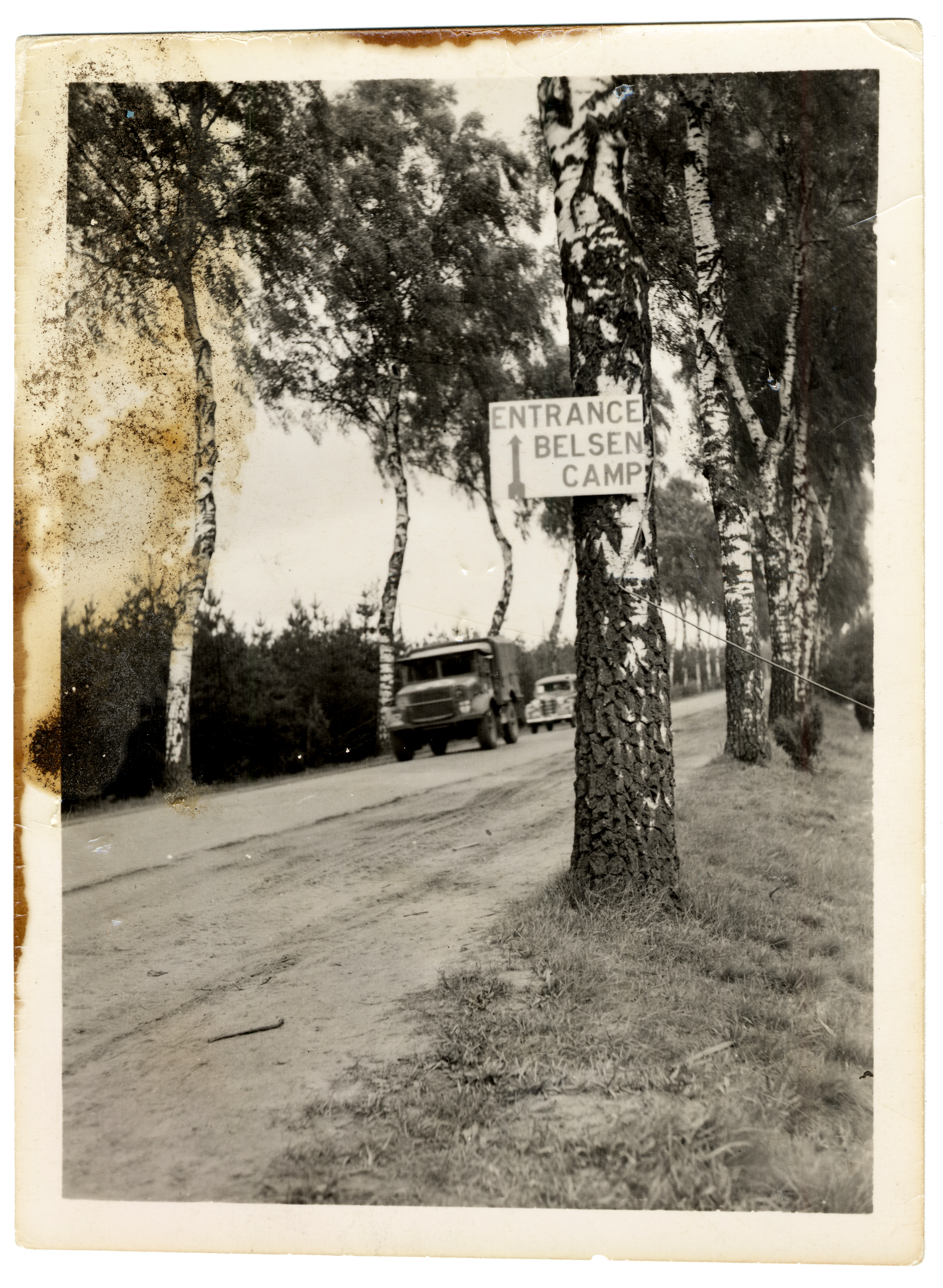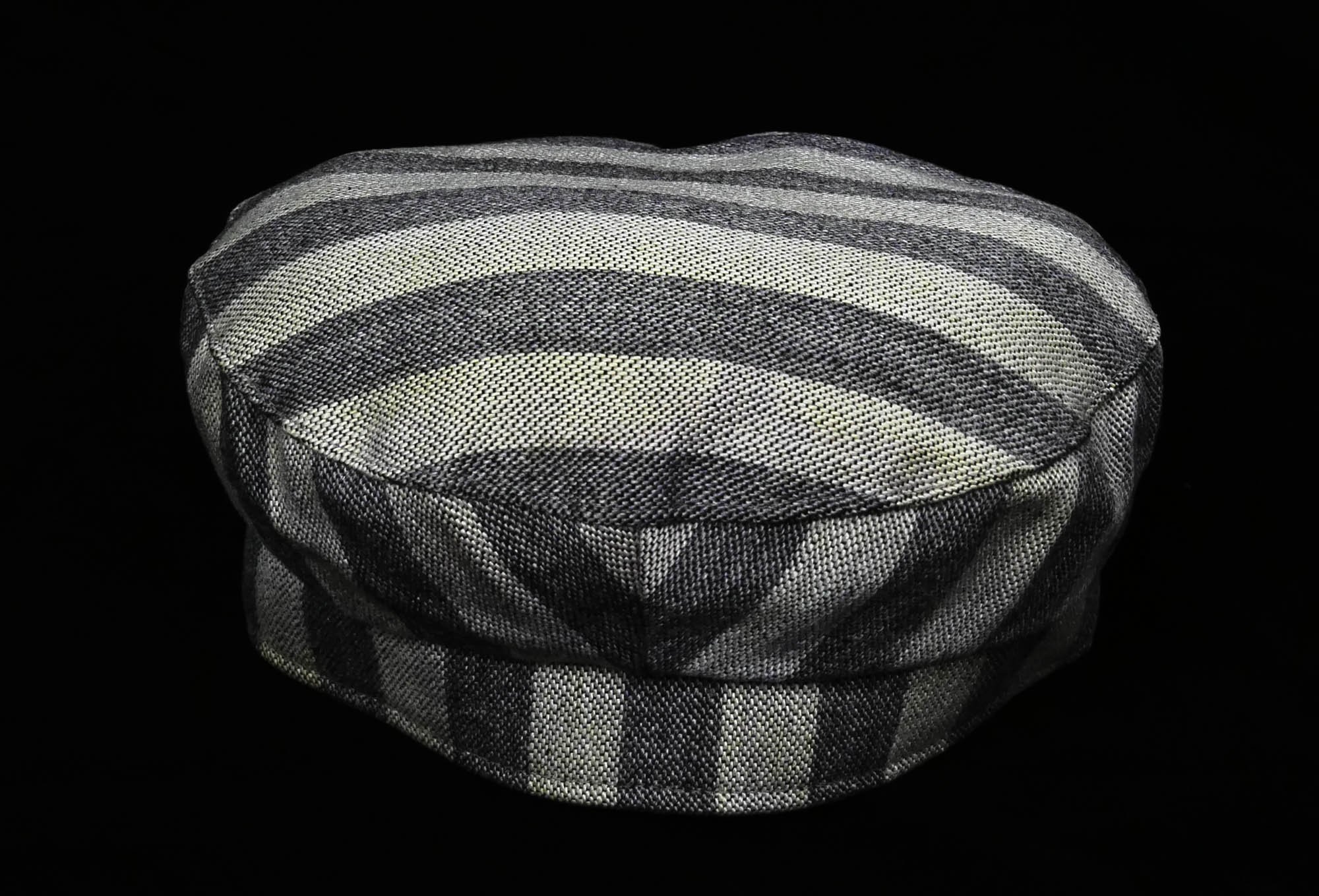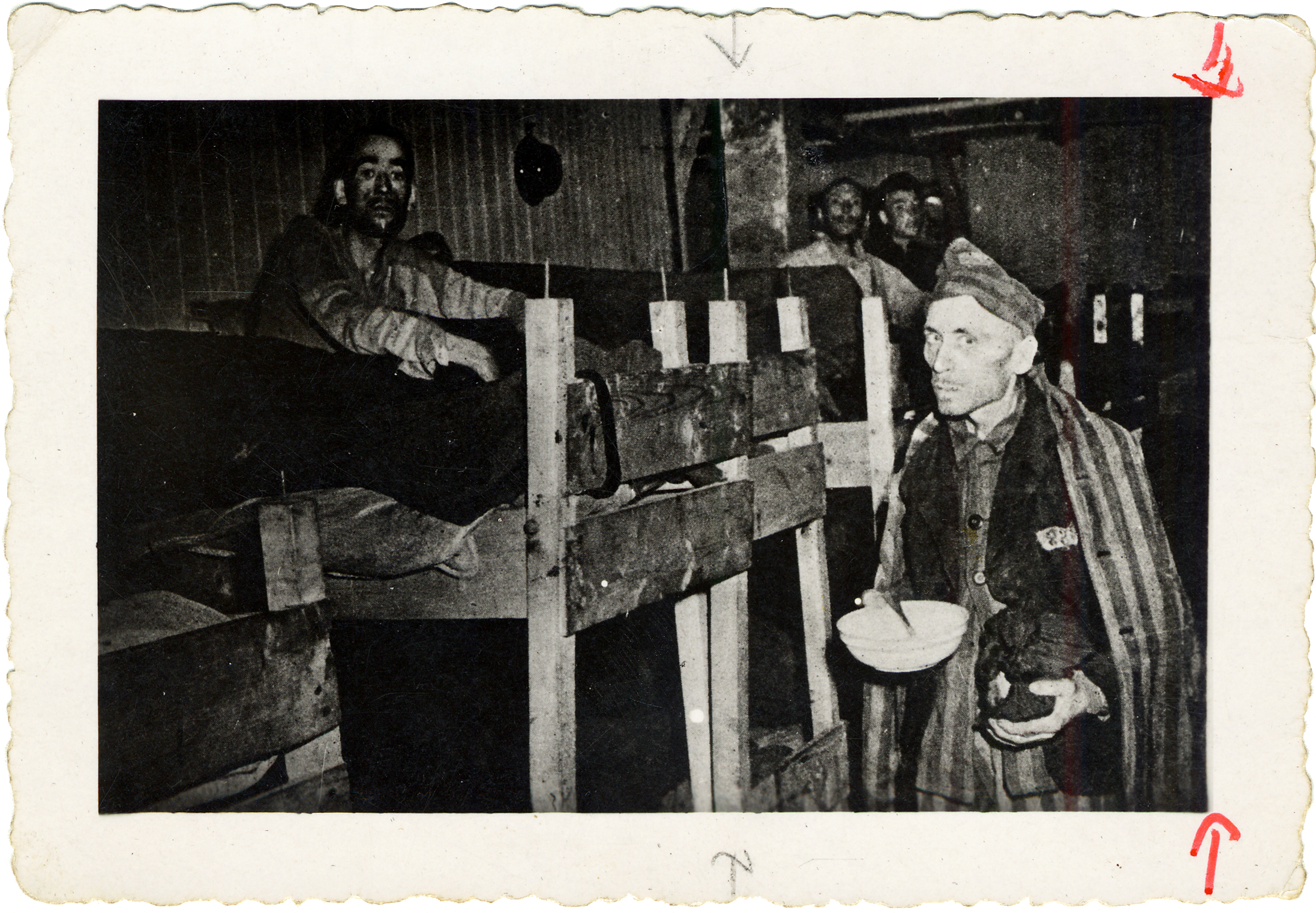
AFTER THE UNIMAGINABLE
OUR VOICE
IN-HOUSE EXHIBITION APRIL 1 - JULY 1, 2025
IN COLLABORATION WITH THE MONTREAL HOLOCAUST MUSEUM
In commemoration of the 80th anniversary of the Liberation of Bergen-Belsen and as part of the paul and babey trepman memorial lecture series, the Jewish Public Library Archives and the Montreal Holocaust Museum are pleased to co-present this online exhibit. We invite you to learn about the period post-Liberation, and to discover how survivors took to documenting their experiences as a form of healing.
Special Notice: This exhibition includes a variety of images, documents, and artifacts related to the Holocaust. It features materials and challenging topics that may be difficult for some viewers, such as antisemitic descriptions, Nazi imagery and ideology, portrayals of German concentration camps, graphic representations of Holocaust violence, and the founding of the State of Israel.
Located south of the small towns of Bergen and Belsen, about 11 miles north of Celle, Germany, the Bergen Belsen camp complex was initially set up for Jewish hostages whom the SS claimed they would release in exchange for Germans interned abroad. After evacuating these POWS further east, it became a concentration camp in 1943.
In December 1944, the Bergen-Belsen concentration camp became the destination for numerous evacuation transports from other concentration camps. Inadequate sanitation, overcrowding, lack of adequate food, water, and shelter led to an outbreak of diseases such as typhus, tuberculosis, typhoid fever, and dysentery. In the first few months of 1945, tens of thousands of prisoners died.
On April 15, 1945, British forces liberated Bergen-Belsen, finding around 55,000 prisoners in the camp, many of them seriously ill. Belsen was transformed into a Displaced Persons (DP) camp. The response to the crisis -- burying the dead, containing the spread of disease, restoring the water supply and arranging the distribution of food suitable for starving prisoners in various stages of malnutrition -- did not save close to 14,000 prisoners who died after Liberation. Belsen was one of hundreds of DP camps that were established across occupied Germany. Primarily in the British and American Zones, they served as temporary homes for Jewish survivors, featuring their own administration, schools, theatres, and social sports leagues. The final DP camp closed in 1957, 12 years after Liberation.

Entrance to Bergen-Belsen Camp, Celle, Germany April 1945, Courtesy of the Montreal Holocaust Museum, ID: 2011X.70.02

Commemorative hat created for Joseph Fishman, who, during the Holocaust, was deported to Auschwitz and later to Bergen-Belsen, where he was liberated. Fishman went on to help establish the first Holocaust Museum in North America. Courtesy of the Montreal Holocaust Museum, ID: 2015.08.02

Photo of men's barracks shortly after the liberation of Bergen-Belsen, April 1945. Courtesy of the Montreal Holocaust Museum, ID: 1990.22.07

An Anthology of Songs and Poems. Includes poems from Lodz (Litzmannstadt) ghetto and the Partisan song by Hirsh Glik. Published by Holocaust survivors in Bergen-Belsen Displaced Persons camp. January, 1946. Courtesy of the Montreal Holocaust Museum, ID: 2011X.337.01

Paul Trepman in his prison uniform at Bergen-Belsen. 1945. Courtesy of the Montreal Holocaust Museum, ID: 1990.89.1

Royal Canadian Air Force truck in a village near Bergen-Belsen after the Liberation. There is a sign giving directions to “Belsen con camp, 18 miles via Winsen”. 1945. Courtesy of the Montreal Holocaust Museum, ID: 1997.20.14

These eyeglasses belonged to Teréz (Theresa) Spiegel, who was killed in Auschwitz. Teréz was the donor’s sister. The donor carried the glasses with her on a death march from Auschwitz to Bergen-Belsen in 1944. Courtesy of the Montreal Holocaust Museum, ID: 1995.17.01
First-hand account of Kol Nidre and Yom Kippur services with Jewish survivors in the Bergen-Belsen Displaced Persons Camp. Written by Abraham Brenner, one of ten Jewish Canadian soldiers who attended the services. September 17, 1945. Courtesy of the Montreal Holocaust Museum. ID: 2000.64.01
In their own words
Sarah Grey (née Konsker) was born on May 30, 1930, in Lodz, Poland. After the Germans occupied Lodz in 1939, Sarah and her family were forced into the ghetto in early 1940, where she worked as an embroiderer. Sarah recalls the residents of the ghetto tried to get Rumkowski’s favor, in the hopes they would not be deported, and her parents created a portrait of Rumkowski, hoping to gain his favor. The family remained in the ghetto until 1944, when they were deported to Auschwitz. Sarah was later sent to a labor camp in Poland, where she was eventually liberated. After returning to Lodz and facing antisemitism, she moved to the Bergen-Belsen DP camp. She later immigrated to Israel in 1947 before settling in Montreal, where she married a fellow Holocaust survivor and had three children.
Liselotte Ivry was born in 1925 in Listany (Czech Republic). Her parents owned a general store, which her mother, Elsa, ran alone after her husband's untimely death in 1928. In 1942, the family was sent to the Terezin ghetto camp in the Czech Republic, where they spent a year. In July 1944, Liselotte is transferred to the Neuengamme concentration camp near Hamburg (Germany). She was assigned to forced labor in a Hamburg brickwork. In February 1945, Liselotte's group of prisoners is caught up in the bombing of Dresden (Germany). All were sent to the Bergen-Belsen concentration camp (Germany). On April 15, 1945, they were liberated by the British army.
Lily Meisner was born on October 30th, 1921, in Lodz, Poland. The family was active in the Bund, a movement whose credo is that Jewish life should be established and maintained in Poland and not the Jews' biblical home of Palestine. In total, Lily was in six different camps. From Bligin, she went to Auschwitz for four months and saw her brother for the final time there. From Auschwitz, she went to Hindenburg where she was part of a death march. Following this, she went to Dora Norhausen, a men's camp, and she was finally liberated in Bergen Belsen. Lily and her future husband Mr. Meisner stayed in Bergen-Belsen for five months. They both worked on a committee that collected children's poetry. One day, they received a letter from the Bund stationed in Belgium telling them somebody would take them there. Upon liberation, Lily did not feel elated or free; she felt an indescribable "numbness". Lily feels that the word "dehumanized" and not "slave" properly describe the situation she was cast in during the Holocaust.
Sara Ostrzega (née Orner) was born in 1923 in Lodz, Poland. During World War II, her family was forced into the Lodz ghetto, where they endured harsh conditions. In 1944, they were deported to Auschwitz, where she was separated from her father and brother. She and her mother were later sent to Stutthof and then Dresden for forced labor. In March 1945, Sara survived an Allied bombing and escaped from a train bound for Theresienstadt, hiding for four weeks. After the war, she reunited with her family in Lodz but faced antisemitism. She married and fled to Germany with her husband, living in the Bergen-Belsen DP camp, where she had a son in 1946. In 1948, they immigrated to Canada.
Interview with Paul TREPMAN, Co-Editor of the Unzer Sztyme
Paul Trepman was born in Warsaw, Poland in 1916. He received both a modern and traditional education. His studies at the Stefan Batory University in Vilna were interrupted by the spread of war, and he spent several years successfully hiding his Jewish identity through the use of false Aryan identity papers. Accused of being a Soviet spy, he was arrested in June 1943 and sent to Majdanek, transiting through several camps, and finally ending up in Bergen-Belsen until it was liberated by the British in 1945. Trepman did not reveal his Jewish identity until weeks after Liberation, but was thereafter highly involved in the political and cultural spheres of life in the Bergen-Belsen displaced persons camp. He was the founding coeditor of the Unzer Sztyme publication, established just months after Liberation.
With the help of Hirsch Wolofsky, the editor of Montreal's Yiddish daily Keneder Adler, Trepman and his wife immigrated to Montreal in 1948. He was soon hired to teach at the Jewish People’s Schools, where he worked for 23 years. During the summers, he served as the director of the Labor Zionist Camp Undzer – Camp-Kindervelt. From 1971 to 1981, Trepman held the position of executive director at the Jewish Public Library of Montreal. Over time, he became a key figure in the Montreal survivor community. In 1961, he founded the Montreal chapter of Bergen-Belsen survivors and served as its president for several years.
In Montreal, Trepman was an active contributor to the Keneder Adler, often writing under various pen names, including the playful “Pinchas Batlan” (Pinchas the Loafer). He also authored several books about his life before and during the war. These include A Gesl in Varshe (1949; Among Men and Beasts, 1978), a collection of newspaper articles he had written between 1946 and 1953, and A Traumatic Return to Poland (1980), a translation of six articles about his visit to Poland in 1979, originally written for the Keneder Adler.
In 1987, just before his death, Trepman sat down with his son Elly to discuss the first days of the Liberation, his reintegration into the Jewish camps, and the establishment of the first Yiddish paper after Hitler's reign, Unzer Sztyme. Video Courtesy of Elly Trepman.

Copy of original drawing, men moving furniture into truck under Jewish banners. Crate in foreground reads 'Bergen-Belsen / Tel Aviv.' Sketched by Sylvia Benjamin-Markowitz, 1947. Courtesy of the Montreal Holocaust Museum, ID: 2011X.75.01
Edith Reh received this armband from German authorities upon entering the ghetto-camp of Theresienstadt in April 1944. She later inscribed the names of the four different camps she had been interned in, Auschwitz, Bergen-Belsen, Leipzig and Terezin, as a memento of her survival through the Holocaust. Courtesy of the Montreal Holocaust Museum, ID: 2011X.263.02

Displaced Persons Identification card of Mendel Berlach issued by the Allied Expeditionary Force in Ainring Displaced Persons Camp. May 14, 1946. Courtesy of the Montreal Holocaust Museum, ID: 1999.28.12

The Voice of Survivors publication, 1963. Courtesy of the Montreal Holocaust Museum, ID: 2011X.41.13

Paul Trepman standing on the wreathed steps to the Bergen-Belsen stone memorial column next to young boy and Yossel Rosensceft at far right, 1947. Courtesy of the Montreal Holocaust Museum, ID: 1990.108.12

Immunization card of Tobiasz Rosengarten at Bergen Belsen DP camp, 1948. Courtesy of the Montreal Holocaust Museum, ID: 1997.06.18
Unzer Sztyme
Our Voice yiddish paper
In July 1945, just months after Liberation, Paul Trepman, along with David Rosenthal and Rafael Olewsky, founded the Unzer Sztyme (Our Voice), an unprecedented publication and the first Yiddish newspaper in the British Zone. There are 24 editions of Our Voice, plus two bonus editions, released between 1945 and 1947. The Jewish Public Library holds one of the only complete sets in the world, part of the Paul Trepman Fonds.
The bi-weekly publication was originally handwritten by Rosenthal himself, and it features a series of literary works, poetry, art, partisan songs, and more. The immediacy of the publication and its contents truly embodies the hardships, anger, hope, and healing expressed by survivors. The JPL Archives is hard at work to translate each edition into English, and you can view every volume, including some with translations, on our online catalogue.
The Montreal Holocaust Museum
The Montreal Holocaust Museum (MHM) educates people of all ages and backgrounds about the Holocaust, while sensitising the public to the universal perils of antisemitism, racism, hate and indifference. Through its Museum, its commemorative programs and educational initiatives, the Montreal Holocaust Museum promotes respect for diversity and the sanctity of human life.
The Jewish Public Library Archives would like to give a special thanks to the Collections team of the MHM, Sara Juneau and Dominique Trudeau, for their tireless assistance with the creation of this joint exhibition.
address
5151, chemin de la Côte-Sainte-Catherine
Montreal (Quebec)
H3W 1M6 Canada
contact
514-345-2605
info@museeholocauste.ca
Alongside this exhibition, the Jewish Public Library Archives, the Montreal Holocaust Museum, and the Dora Wasserman Yiddish Theatre of the Segal Centre for Performing Arts held an event on April 1, 2025 to commemorate Bergen-Belsen. Follow this link to the event recording on YouTube.




![Unzer Sztyme Title Page, Printed, Issue 1, July 12, 1945. JPL Archives, ID: 1069_[33]_1](https://images.squarespace-cdn.com/content/v1/62b48292d1bcbc071b15094c/5f2a922e-52d5-4217-afdc-4a7a9d1c7ad5/UnzerSztyme_1945_Issue-1_01.jpg)
![Unzer Sztyme Title Page, Handwritten, Issue 1, July 12, 1945. JPL Archives, ID: 1069_[33]_1.1](https://images.squarespace-cdn.com/content/v1/62b48292d1bcbc071b15094c/3f622e39-f119-4d7d-9733-8fcad904879d/UnzerSztyme_1945_Issue-1_03.jpg)
![Unzer Sztyme Title Page, Handwritten, Issue 3, July 12, 1945. JPL Archives, ID: 1069_[33]_3.1](https://images.squarespace-cdn.com/content/v1/62b48292d1bcbc071b15094c/11bd2b7f-d0ed-444d-adc1-2219328aa629/UnzerSztyme_1945_Issue-3_03.jpg)
![Illustration of abstract figures in front of a great wall, Unzer Sztyme, Issue 3, September 10, 1945. JPL Archives, ID: 1069_[33]_3.5](https://images.squarespace-cdn.com/content/v1/62b48292d1bcbc071b15094c/86d803be-6fd0-4a9e-b8f4-67242fb03067/UnzerSztyme_1945_Issue-3_07.jpg)
![Illustration of hand holding fountain pen and tracing cursive Yiddish down one side with ornate Art Deco motif at the bottom, Unzer Sztyme, Issue 3, September 10, 1945. JPL Archives, ID: 1069_[33]_3.6](https://images.squarespace-cdn.com/content/v1/62b48292d1bcbc071b15094c/04e36d28-3fdc-41d2-8e64-095ea64f572d/UnzerSztyme_1946_Issue-3_08.jpg)
![Illustration of a young man in concentration camp wearing striped uniform, with the spirits of his parents
reaching down for him from beyond the wired fence, Unzer Sztyme, Issue 3, September 10, 1945. JPL Archives, ID: 1069_[33]_3.14](https://images.squarespace-cdn.com/content/v1/62b48292d1bcbc071b15094c/81883979-b130-4a7c-9266-eb754348179a/UnzerSztyme_1945_Issue-3_16.jpg)
![Unzer Sztyme Title Page, Handwritten, Issue 4, October 15, 1945. JPL Archives, ID: 1069_[33]_4.1](https://images.squarespace-cdn.com/content/v1/62b48292d1bcbc071b15094c/9ba95eef-54aa-4ca5-b165-c29b753b9b94/UnzerSztyme_1945_Issue-4_22.jpg)
![Illustration of armed partisans among trees, with refrain and musical score for the hymn "Never Think That You Are Going Your Last Way" by Hersh Glick, Unzer Sztyme, Issue 4, October 15, 1945. JPL Archives, ID: 1069_[33]_4.9](https://images.squarespace-cdn.com/content/v1/62b48292d1bcbc071b15094c/7b2c3317-ffd3-4718-9de6-dddb974e1fc6/UnzerSztyme_1945_Issue-4_30.jpg)
![Illustration of flag with swastika on the ground with discarded and broken rifle and sword beside, Unzer Sztyme, Issue 4, October 15, 1945. JPL Archives, ID: 1069_[33]_4.24](https://images.squarespace-cdn.com/content/v1/62b48292d1bcbc071b15094c/4931516b-9c67-442b-87dd-ce5d0f6bf2ab/UnzerSztyme_1945_Issue-4_45.jpg)
![Illustration of barbed wire fence with photogtaphs of guarded and murdered Jews on either side, Unzer Sztyme, Issue 4, October 15, 1945. JPL Archives, ID: 1069_[33]_4.35](https://images.squarespace-cdn.com/content/v1/62b48292d1bcbc071b15094c/09404bf4-3aeb-4673-86a4-2bd8e1a3d027/UnzerSztyme_1946_Issue-4_56.jpg)
![Unzer Sztyme Graphic Title Page, Issue 18, March 1, 1947. JPL Archives, ID: 1069_[33]_18.1](https://images.squarespace-cdn.com/content/v1/62b48292d1bcbc071b15094c/13f9f1ad-1ec8-44bd-9015-2b738277eadf/UnzerSztyme_1947_Issue-18_01.jpg)
